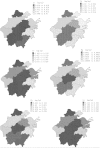Levels and potential health risk of heavy metals in marketed vegetables in Zhejiang, China
- PMID: 26831758
- PMCID: PMC4735810
- DOI: 10.1038/srep20317
Levels and potential health risk of heavy metals in marketed vegetables in Zhejiang, China
Abstract
The present study analyzed 5785 vegetables for concentrations of As, Cd, Cr, Pb, Ni and Hg, and estimated the health risk to local consumers by deterministic (point estimates) approaches. Levels of elements varied in different vegetables. Average levels of As, Cd, Cr, Ni, Hg and Pb were 0.013, 0.017, 0.057, 0.002, 0.094 and 0.034 mg/kg (fresh weight), respectively. The samples with 0.25% for Cd and 1.56% for Pb were exceeding the maximum allowable concentrations (MACs) set by the Chinese Health Ministry. No obvious regular geographical distribution for these metals in vegetables was found in areas of Zhejiang, China. The mean and 97.5 percentile levels of heavy metal and metalloid were used to present the mean and high exposure assessment. The health indices (HIs) were less than the threshold of 1 both in mean and high exposure assessment. It indicates that for the general people there is very low health risk to As, Cd, Cr, Pb, Ni and Hg by vegetable intake.
Figures



References
-
- Sipter E., Rozsa E., Gruiz K., Tatrai E. & Morvai V. Site-specific risk assessment in contaminated vegetable gardens. Chemosphere 71, 1301–7 (2008). - PubMed
-
- Khan S., Aijun L., Zhang S., Hu Q. & Zhu Y. G. Accumulation of polycyclic aromatic hydrocarbons and heavy metals in lettuce grown in the soils contaminated with long-term wastewater irrigation. J Hazard Mater 152, 506–15 (2008). - PubMed
-
- Kumar Sharma R., Agrawal M. & Marshall F. Heavy metal contamination of soil and vegetables in suburban areas of Varanasi, India. Ecotoxicol Environ Saf 66, 258–66 (2007). - PubMed
-
- Oves M., Khan M. S., Zaidi A. & Ahmad E. Soil contamination, nutritive value, and human health risk assessment of heavy metals: an overview-oxicity of heavy metals to legumes and bioremediation, (Springer, 2012).
MeSH terms
Substances
LinkOut - more resources
Full Text Sources
Other Literature Sources
Medical
Molecular Biology Databases
Research Materials
Miscellaneous

